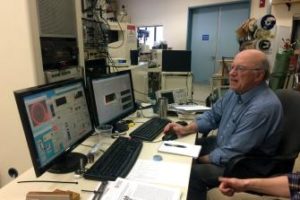Hybrid Gas Ion Source Development
NOSAMS has installed a hybrid gas ion source from NEC as the final stage in upgrading the NOSAMS Tandetron AMS system (USAMS). This source can run either graphite samples or carbon dioxide (CO2). Earlier stages of this upgrade included replacing the original simultaneous (recombinator) injector with a sequential (bounced) injection system of our own design and upgrades to the rare and abundant isotope detection hardware and software.

Karl von Reden taking data for the first run of the NOSAMS hybrid gas ion source.
The hybrid sputter gas ion source allows direct measurement of radiocarbon in CO2 without first converting to graphite. A flow of CO2 is streamed across a titanium target cathode under cesium sputtering. After dissociation of CO2, negatively charged ions are extracted by an acceleration potential.
Initial tests showed that the source produces 10µA (about 1/10th the current of graphite targets ) of C– with an optimal flow of pure CO2,. This allows measurement of modern samples to 1% precision in about 30 minutes. Measurement of radiocarbon-free CO2 shows a blank of about 1% of modern carbon. All of these parameters are in the range of typical published performance for other hybrid gas ion sources.
We are now developing inlet systems to interface with the hybrid source. Two approaches are in development, a closed system that allows control of sample flow by adjusting the volume of the inlet using a bellows, and an open split which will introduce sample gas at a set flow defined by the inlet capillary. For large samples, the open split will join systems already developed for the CFAMS microwave gas ion source to the hybrid source. For smaller samples, we are considering inlet systems based on a low pressure, low volume closed system.
In the gas accepting mode, the hybrid source will initially be used for the rapid measurement of samples at lower precision. At the outset we will measure 100-500µg samples, but we hope to expand this to smaller samples in the 10-100µg range. We plan to focus initially on samples already converted to CO2, followed by development of automated hydrolysis (gasbench) for carbonates and an elemental analyser interface for organic samples. Additionally a simple apparatus for rapid measurement of DIC in seawater via acid hydrolysis in a helium carrier stream or REDICS-style CO2 production using a gas-permeable membrane is possible.
